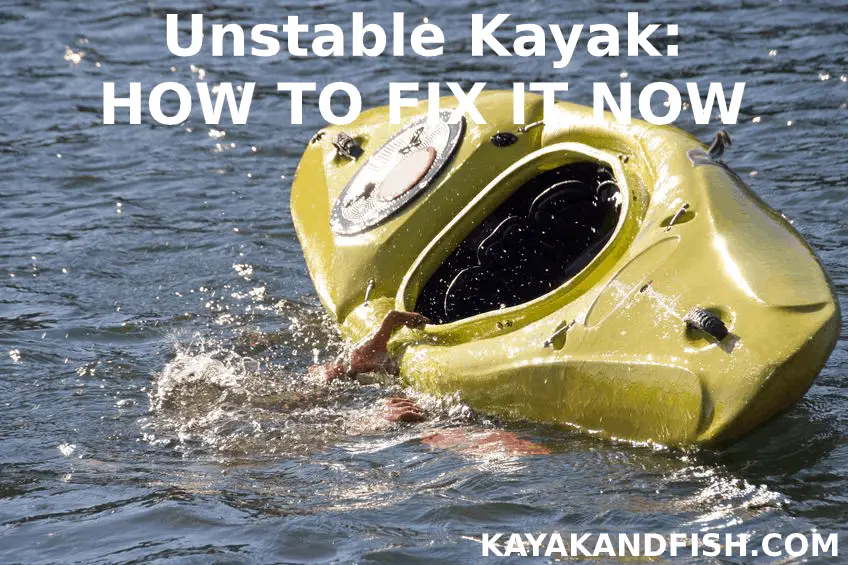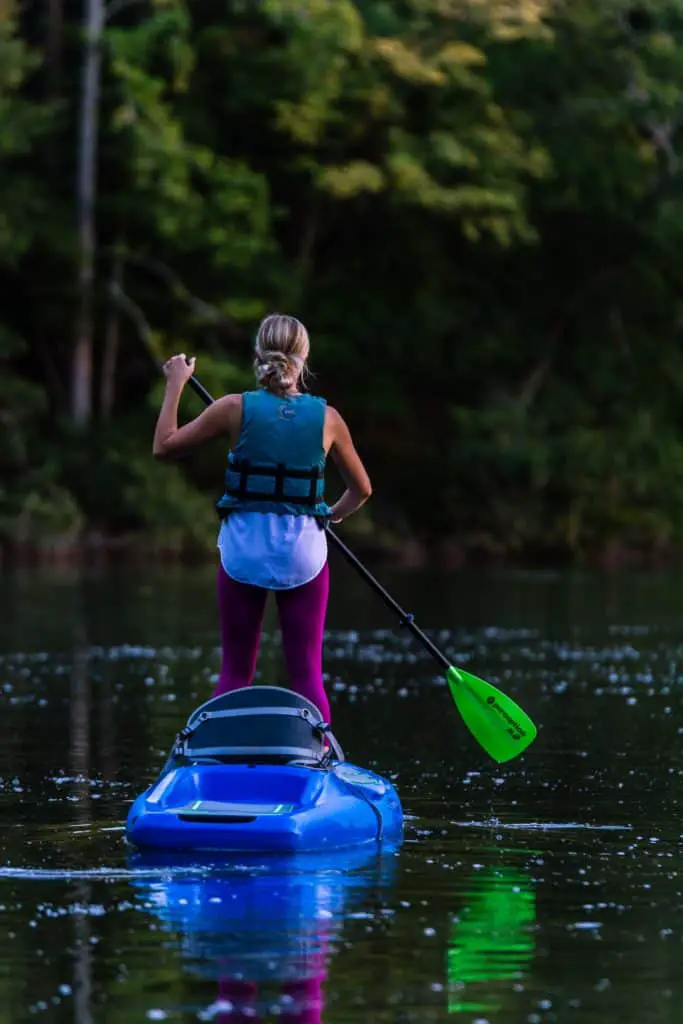
If you’re new to the world of kayaking, one thing that might make you feel uneasy is a boat that’s wobbly or tipsy. After all, the last thing you want is to flip your kayak and end up in the water, especially if you can’t swim. So, if you’re feeling unstable in your kayak, you need to know why it’s happening and how to fix it now.
Why is my kayak so unstable? There are several reasons that your kayak may feel unstable. You may be using the wrong type or shape of kayak for your particular activity, or there may be an uneven distribution of weight.
Knowing what’s making you feel unstable in the kayak is the first step in regaining your balance. I’m going to cover what affects the initial stability of the kayak itself, as well as what can occur out on the water to cause wobbling. I’ll also hit on tips and tricks for you to stay stable so you can enjoy kayaking.
What Affects the Stability of a Kayak?
When buying a kayak, you need to understand how important it is to find one that suits your needs. Someone who is into racing will want a leaner, quicker kayak while someone who is going for a stroll on the lake will need something wider and more relaxed. Kayaks are built for specific uses on various types of water, for example, a touring kayak has a wide bottom and does not perform well in fast-moving rivers.
Three things will affect the initial stability of a kayak before it even touches the water:
- The overall width of the kayak. This is probably the most crucial element when it comes to kayaks and their stability. The wider the boat, the better the buoyancy it will have. As there is more surface area, the kayak won’t sway as much and will be better able to stay upright in the water.
- The shape of the kayak’s hull. The hull is designed in a specific way to cater to people’s needs. Someone who enjoys riding the waves will find that a rounded hull works best, but they are far more difficult to keep upright. A flat hull, on the other hand, is ideal for those who want a kayak that essentially stays upright on its own.
- The weight distribution is off. Aside from the width and shape, the biggest cause of a wobbly kayak is awkward weight distribution. When there is too much weight in one area of the boat, it may feel like you’re going to fall off because there is no center of gravity.
The best way to ensure your kayak will remain stable on the water is to buy a boat with the width and shape you need. Remember that a wider kayak with a flat hull is ideal for beginners because they’re easier to stay stable on the water.

If you’re not paddling properly, it can also have a big impact on your overall balance in the water. If you find yourself struggling while paddling, you may benefit from taking a balancing class or researching some better methods of staying upright and secure in your kayak.
Paddling improperly will cause an insane amount of problems like causing your kayak to pull in one direction. Learning proper paddling technique is insanely important! To make sure that you’re up to speed on paddling, check out this video on YouTube.
How to Make Your Kayak More Stable
If you bought the right kayak for your needs and are still finding yourself struggling with balance, you might need to make modifications to even out your ride. Some of the best ways to enhance your overall stability in the water include:
- Ensuring there is equal weight distribution. Remember that to much weight in one area of the kayak is going to lead to wobbling and a tipsy kayak. Always make sure there’s equal weight distribution between your gear. If you have to, you can try adding some more weight to your kayak by using something heavy like a bag of sand or rocks.
- Lowering your seat. This is one of the easiest things you can do, and it works like a charm. By simply lowering your seat, you will be creating a better center of gravity and feel far more secure in the water. This may impact you’re paddling a tad, making it more difficult initially, but it’s worth it.
- Buy a stabilizer. Did you know that you can actually purchase a stabilizer and install it to your kayak? These stabilizers have extra-long arms that will help you keep you balanced in the water. They’re a great choice for those who have seemingly tried everything, only to end up feeling wobbly still. YakGear is a reputable brand and manufactures an outrigger (Amazon), however, it is a bit pricey depending on how much you paid for your kayak.
- Try a different kayak. If it seems like you’re having no luck with finding balance on the water, it might be time to try out a different one. Every kayak will feel different to every paddler, so finding the one that is right for you might take a little bit more time and effort. You should ALWAYS demo several kayaks before purchasing one to ensure that you purchase the right one for you.
- Pay attention to weight when using a two-seater. One issue you may run into when using a two-seater kayak is that the weight distribution is off because one individual is heavier than the other. This can be adjusted by adding more weight to the area where the lighter person is kayaking.
- Consider a short, sit-on-top kayak. For beginners, one of the best routes to go is a sit-on-top model: the shorter and the wider, the better, as it will offer you the best balance possible. Most of the time they are also a cost-effective choice compared to other kayaks on the market.
- Practice makes perfect. When you’re just starting out, you’re definitely going to feel a wobbly sensation. It is hard to find your balance when paddling along the water, but the best thing to do is to keep practicing. You may want to get some tips and tricks from other paddlers or consider taking a class to boost your technique.
It’s fairly simple: either you need to even out your ride by adding/removing weight or lowering your seat, or you need to modify your technique or kayak for premium results. Remember that it might take a little bit of mixing and matching until you find the stability you desire.

Which Model of Kayak Is Most Stable?
The most stable models of kayaks on the market are going to be wider and have a flat hull. This is due to the fact that they have a larger surface area and won’t be so prone to wobbling and feeling tipsy.
There is no other way to say it, cheap kayaks just don’t perform like premium models. Name brands like Hobie, FeelFree, Jackson, Ascend, just to name a few are the way to go if you’re serious about kayaking. Kayaks from Walmart or DICK’s Sporting Goods that are under 1000 dollars just aren’t good quality.
Sit-on-top kayaks
These kayaks don’t have a cockpit. As you might have guessed, you don’t sit in them; you sit on top of them. Sit-on-tops (SOTs) tend to be more stable, with a higher center of gravity and generally, a wider design. This makes it an ideal choice for those who are just starting out with kayaking or someone who just wants to paddle leisurely around the lake.
Fishing Kayaks
You might also want to check out a kayak designed for fishing. These kayaks are going to be wider and designed for relaxation and recreational uses. Think about it: it would be almost impossible to fish on a wobbly boat, and that’s why fishing kayaks make balance a breeze.
The Jackson Big Rig is a super-sized kayak designed for a bigger load. These kayaks are insanely stable.
Other Models
When you’re ready to step up and challenge your skills, then you can move on to kayaks that require more balance and technique from the user. Whitewater and racing kayaks are certainly two of the most difficult kayaks to ride, but they open up the opportunity for some amazing adventures once you get the hang of them.
Conclusion
Kayaking might be challenging in the beginning, especially if you’re boat is feeling excessively wobbly and tipsy. Always make sure you’re buying a kayak that fits your needs with the best initial stability. From there, play around until you get the right weight distribution and make modifications as needed until your kayak feels balanced in the water.

